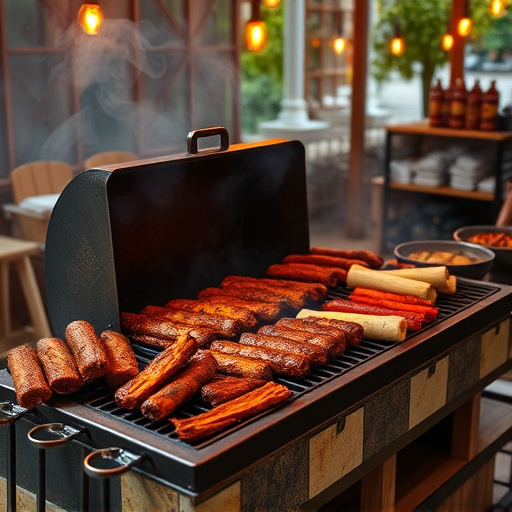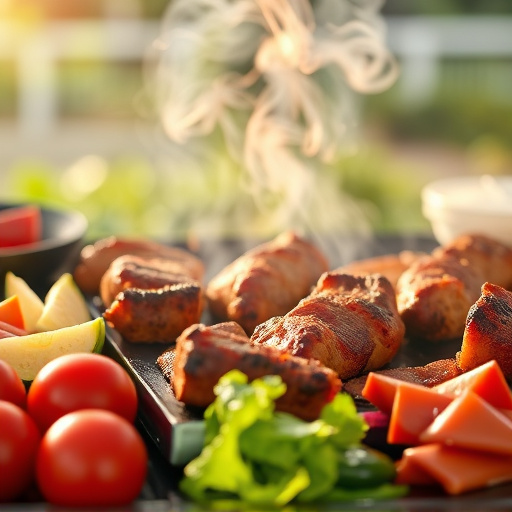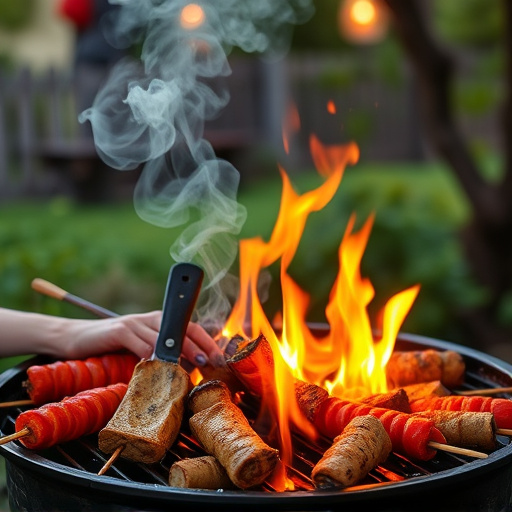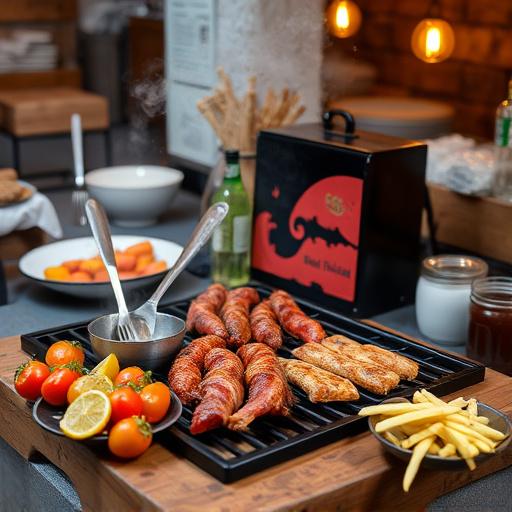BBQ jerky, an ancient snack with global appeal, offers a diverse range of meats and flavors. Crafting the perfect recipe involves choosing lean cuts for tenderness and proper slicing techniques. Exploring exotic meats like bison or venison adds unique taste profiles. Seasonings and marinades are key to flavor infusion, with options like garlic, paprika, and soy sauce. Air-drying or dehydrating determines the desired texture: chewy or crispy. Experimentation leads to personalized recipes, ensuring a satisfying BBQ jerky experience.
“Unleash your inner BBQ connoisseur as we embark on a tantalizing journey through the world of jerky. This ultimate guide delves into the art of crafting the perfect BBQ jerky recipe, exploring diverse meats beyond the conventional. From the classic beef ribs to exotic options like chicken and unique cuts, each selection offers a distinct flavor profile. Learn the secrets behind selecting the ideal meat cut, mastering seasoning techniques, understanding drying methods, and creating innovative recipes that will revolutionize your BBQ experience.”
- Understanding BBQ Jerky: Its History and Popular Varieties
- Selecting the Right Cut of Meat for a Tasty Jerky Experience
- Exploring Beef: From Traditional Ribs to Unique Cut Options
- Chicken Jerky: A Lean and Healthy Alternative
- Exploring Exotic Meats for a Bold Flavor Profile
- Seasoning and Marinades: Unlocking Flavor Potential in Each Slice
- Drying Techniques: Influencing Texture and Crunch Factor
- Creative BBQ Jerky Recipes: Beyond the Basic Flavor Combinations
Understanding BBQ Jerky: Its History and Popular Varieties

BBQ jerky, a delightfully savory and portable treat, has been enjoyed for centuries as a delicious snack. Its origins can be traced back to ancient times when meats were preserved using smoke and salt, a method that created durable, flavorful snacks perfect for travel. Over time, this practice evolved into the art of making jerky, with each region developing its unique variations. Today, BBQ jerky has become a staple in many households, offering a wide array of flavors and textures to suit diverse tastes.
Popular varieties include beef, chicken, turkey, and even exotic meats like venison or ostrich. Each type boasts its own distinct flavor profile, influenced by marinades, spices, and smoking techniques. A classic BBQ jerky recipe typically involves marinating meat in a mixture of soy sauce, vinegar, garlic, and various spices before drying it over smoke at low temperatures. This process enhances the natural flavors, resulting in a tender, crisp snack that’s perfect for outdoor adventures or as a tasty addition to lunchboxes.
Selecting the Right Cut of Meat for a Tasty Jerky Experience

When crafting the perfect BBQ jerky, choosing the right cut of meat is key to a tasty experience. Opt for lean cuts like round, fillet, or sirloin for a tender and flavorful result. These cuts ensure your jerky won’t be rubbery but will instead melt in your mouth. A good rule of thumb is to look for a meat with minimal fat, as excess fat can make the jerky greasy and less crispy.
Consider the marbling within the cut; some fat is essential for flavor, but too much will impact the texture. A balanced approach ensures your BBQ jerky recipe turns out perfectly. Remember, the cutting method also matters; thin slices ensure even cooking and prevent over-drying, resulting in a delicious, crisp, and satisfying snack.
Exploring Beef: From Traditional Ribs to Unique Cut Options

Exploring Beef is an essential part of crafting the perfect BBQ jerky recipe. Traditionally, ribs are a popular choice due to their marbling and rich flavor profile. However, adventurous chefs can venture beyond the usual suspects to discover a world of unique cut options. From tender loins to robust brisket, each cut offers distinct characteristics that can enhance your jerky experience.
Experimenting with various beef cuts allows for creativity in your BBQ jerky preparation. For instance, using leaner cuts like round or sirloin requires specific techniques to ensure they don’t become tough. Conversely, fattier cuts, when selected judiciously, can impart a delightful crunch and mouthfeel to your homemade jerky.
Chicken Jerky: A Lean and Healthy Alternative

Chicken jerky makes for a fantastic, lean, and healthy alternative in your BBQ jerky recipe arsenal. With significantly less fat content compared to traditional red meats, chicken is a popular choice among those seeking a lighter, yet still satisfying, snack. The process of dehydrating chicken meat results in a protein-rich treat that’s both versatile and delicious. Experiment with various marinades and seasonings to create unique flavors tailored to your taste buds.
When making chicken jerky, it’s essential to select high-quality, fresh chicken breast as the base ingredient. Cut the chicken into thin slices or strips to ensure even dehydration, resulting in a tender, crispy texture. A simple BBQ jerky recipe can include a blend of spices like paprika, garlic powder, salt, and pepper. For an extra kick, add a touch of chili powder or cayenne pepper. Always remember to dry the jerky thoroughly in a low-temperature oven or dehydrator to lock in the flavors and ensure a safe, shelf-stable product.
Exploring Exotic Meats for a Bold Flavor Profile

When crafting your next BBQ jerky recipe, don’t be afraid to step out of your comfort zone and explore exotic meats. These options offer a bold flavor profile that can truly elevate your jerky game. From bison and elk to venison and even exotic birds like ostrich or emu, these meats bring unique tastes and textures to the classic BBQ jerky experience.
Each exotic meat has its own distinct characteristics that contribute to an unforgettable jerky experience. For instance, buffalo jerky is known for its rich, hearty flavor and slightly tougher texture, while venison jerky offers a tender, slightly sweet taste with hints of wildness. Experimenting with these meats allows you to create distinctive, mouthwatering BBQ jerky recipes that will impress your friends and family.
Seasoning and Marinades: Unlocking Flavor Potential in Each Slice

Seasoning and marinades play a pivotal role in unlocking the flavor potential of each slice of BBQ jerky. Beyond simple salt and pepper, experimenting with various combinations of spices, herbs, and sauces can dramatically enhance taste profiles. A classic BBQ jerky recipe might include a blend of garlic, paprika, black pepper, and red pepper flakes for a smoky, spicy kick. For a sweeter twist, consider adding brown sugar, cumin, and a touch of soy sauce, resulting in a caramelized, savory flavor.
Marinades further elevate the overall eating experience by tenderizing the meat and infusing it with aromatic flavors. Soy sauce, olive oil, vinegar, and citrus juices are popular choices that not only add moisture but also help break down connective tissues, making each bite incredibly tender. Customizing marinades based on personal preferences allows for a diverse range of BBQ jerky recipes, ensuring every slice is a burst of deliciousness in itself.
Drying Techniques: Influencing Texture and Crunch Factor

When crafting a BBQ jerky recipe, the drying technique employed significantly impacts the final texture and crunchiness of the jerky. Traditional methods involve air-drying, where meat is hung in a cool, dry place for several days or even weeks. This slow process allows moisture to evaporate gradually, resulting in a chewy, dense jerky with a rich, complex flavor. An alternative is using an dehydrator, which controls temperature and humidity more precisely. Dehydrators ensure consistent drying, leading to a lighter, crispier jerky that retains its shape better during handling.
Each method offers distinct advantages. Air-drying produces a deeper, smoky taste due to the longer exposure to ambient air, but it may require more care to prevent over-drying and potential loss of moisture. Dehydrators offer quicker preparation time and are ideal for those who desire a crispier texture without sacrificing flavor. Experimenting with these techniques allows you to tailor your BBQ jerky recipe to personal preferences, ensuring a delightful crunch factor and satisfying, savory taste each time.
Creative BBQ Jerky Recipes: Beyond the Basic Flavor Combinations

When it comes to creative BBQ jerky recipes, the possibilities are only limited by your imagination. Beyond the classic beef and pork blends, there’s a world of meats to explore that can introduce exciting new flavors to your jerky game. Chicken is a versatile option, offering sweet and savory combinations with spices like garlic, paprika, and brown sugar. For an exotic twist, consider turkey or even venison jerky, which can be marinated in a blend of citrus juices and robust herbs like rosemary and thyme.
Experimenting with different cuts of meat allows for unique textures and flavors as well. Lean cuts like chicken breast or turkey chest will result in a lighter, crispier jerky, while fattier cuts such as brisket or shoulder from beef or pork will produce a chewier, richer jerky. Don’t be afraid to mix and match meats and spices to create signature combinations that cater to your taste preferences.
